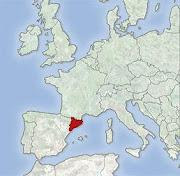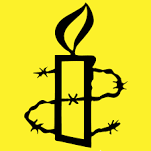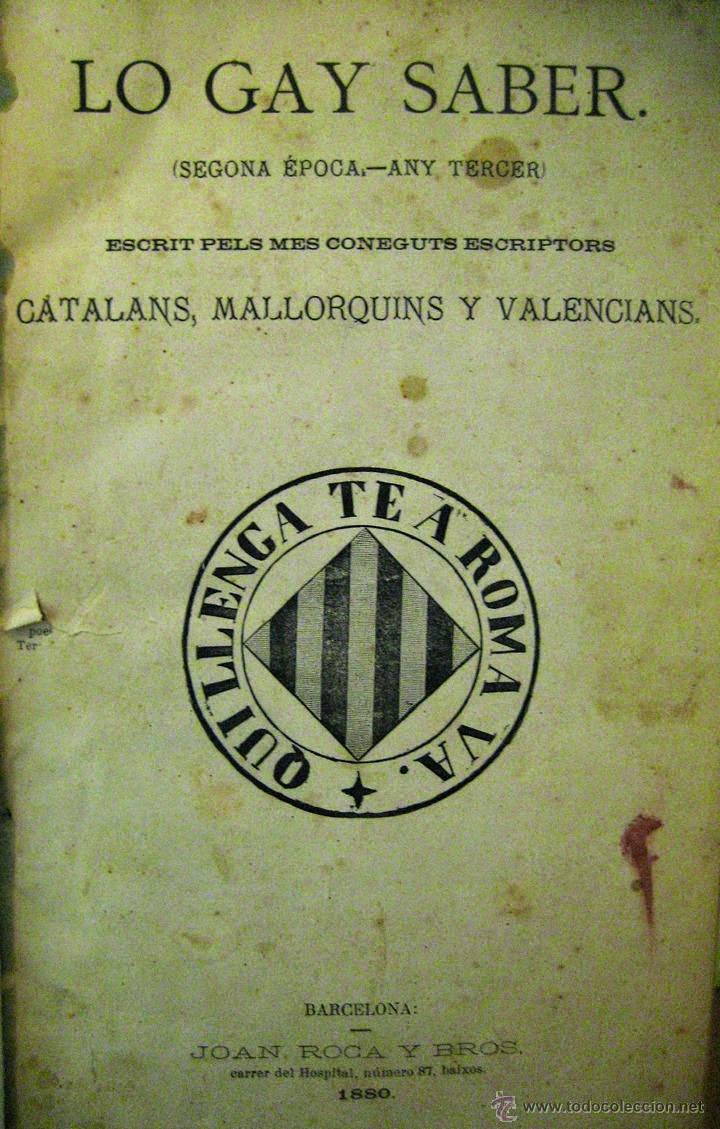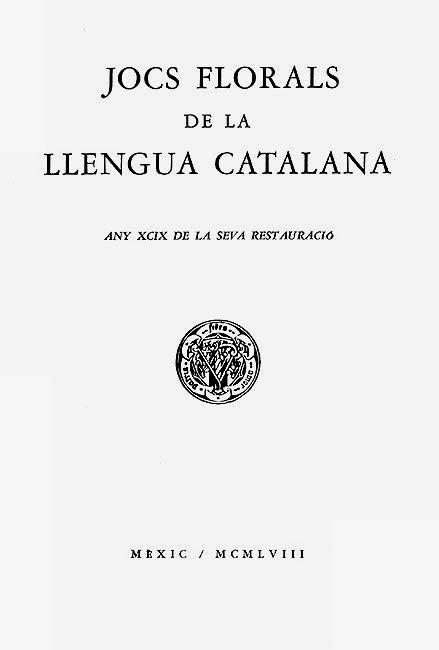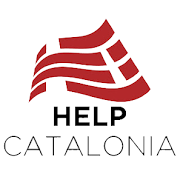Ramon Llull, Palma, Mallorca (Balearic Islands), 1232-1316 was a philosopher, theologian, novelist and poet
Ramon Llull is to Catalan literature what Shakespeare is to English, Dante to Italian, and Goethe to German literature. Llull placed his prose at the service of a great ideal - the peaceful conversion of people to Christianity through highly elaborate, distinct, beautiful, and irrefutable philosophical ideas. His genius is so great -he could write equally well in Latin, Catalan or Arabic- that even today his huge opus (of more than extant 265 titles) attracts the attention of countless literary specialists, philosophers, and theologians around the world.
He was born into a family possibly of noble Catalan stock. His father arrived in Mallorca with the troops of Catalan king James the Conqueror. Llull was born in the island during the period immediately after the conquest, and during his youth he was attached to the royal house. We know relatively little about his years as a courtier - he got married, had two children, and led the life that befitted his station. But at the age of thirty-one he was shaken by an experience that prompted a radical turn to his life - his so-called "conversion" that took place after five apparitions of Christ on the cross.

According to the testimony he offers in his Vida coetània (Contemporary Life), an autobiography dictated by Llull to some Carthusian monks in Paris not long before he died, after this experience a new life started for the convert, who would renounce his family, his social position, and all riches, in order to devote himself fully to the service of God. He did not enter any religious order, but rather conceived of the dedication of his life to God in terms of frenetic activity that can be summarised in three objectives: to preach to the infidels to the point of risking martyrdom; to write a book to refute the errors of these infidels (stating it would have to be "the best book in the world"); and to set up monastery schools where Arabic, together with other oriental languages, would be taught for the instruction of missionaries. In a word, Llull's overwhelming obsession right up to the final moments of his life would be the conversion of Muslims, Jews and other infidels (especially the Tartars) to the Christian faith.
Yet, he lacked proper training for the task he had set himself. In 1265 he embarked on a period of self-education, including the study of Arabic, in the island of Mallorca. The period would end nine years later, in 1274, with the writing of the first great monument of Catalan literature: the huge Llibre de contemplació en Déu (Book of the Contemplation of God - 1273-1274). It was that same year that Llull, in the seclusion of a small hermitage in the Mallorcan mountain of Randa, had the experience of a divine revelation -subsequently known as the "Randa illumination"- in accordance with which he conceived of a system of universal scope to find the truth, a system that would infallibly lead to the conversion of infidels: this is the famous Art lul?liana (Llullian Art), which was to be materialised in the writing of his Art abreujada de trobar veritat (Abbreviated Art of Finding the Truth - 1274). As a result of this he came to be known as "Doctor Illuminatus". From this date onwards, Ramon Llull's life work revolves around his efforts to make his Art known. They include the use of literature as a vehicle for the dissemination of his ideals of reforming Christianity and of conversion of infidels, and he presented his ideas to popes and princes in order to summon the support of the powerful.

Llull was so convinced of his mission that he would travel to North Africa (specifically visiting Bejaia and Tunis) on a number of occasions in order to debate with Muslim theologians. We know that at the end of the year 1315 he was on one of these missionary trips, in Tunis; by around March of the following year, at the age of 83 or 84, he had died. It is unclear whether he died in Tunis itself, in Mallorca or during the return journey from Africa to his homeland: tradition has it that he was stoned to death, thereby becoming a martyr of the faith.
The quest of Ramon Llull's life reveals a strong personality that manifested itself in the feverish activity that led him not just to travel indefatigably, but also to write a considerable number of books in Catalan, Latin, and Arabic (265, according to the latest catalogue compiled by Anthony Bonner). The core issue around which this huge literary opus revolves is the Art dictated to him by God on Mount Randa. All of Llull's works, whether literary or not, refer to this Art, which had to be rewritten a number of times in the attempt to make it more accessible since it clashed with the incomprehension of intellectual circles of the time. Hence, with a view to showing the way through the huge corpus of Llull's writings, critics have mainly accepted a division of his output into four periods, as suggested by Anthony Bonner, in keeping with the various changes the Llullian method underwent in its quest for truth.
The first period, known as the "Pre-Art Period", encompasses the last years of learning before the illumination of Randa (which is to say, between approximately 1271 and 1274). To this period belong the following works: a treatise on Logic in verse (his Lògica d'Algatzel (Logic of Algatzel - 1271-1272?) and the Llibre de contemplació en Déu (The Book of Contemplating God - 1273-1274), Llull's first great work. The "Quaternary Period" covers the years between 1274 and 1290 and is thus known because the basic principles that structure his Art appear in numbers that are multiples of four. The books that form part of the period are Art abreujada de trobar veritat (1274) and Art demostrativa (Demonstrative Art - 1283), and from these works two great novels were derived, Llibre d'Evast e d'Aloma e de Blaquerna (Book of Evast and Aloma and of Blanquerna - 1283) and the Fèlix o Llibre de meravelles (Fèlix or Book of Marvels - 1288-1289). From 1290, and until 1308, when Llull finally abandoned the rewriting of his Art, we witness a drastic reduction in the basic concepts of the method and a major change in the way it functions. The concepts now appear in numbers that are multiples of three, hence the name "Ternary Period" for this stage of Llull's writings. The work Ars inventiva (Art of Invention - 1290) inaugurates this period, which is closed with Art breu (Ars Brevis - 1308). One outstanding work from this time is Arbre de Ciència (Tree of Science - 1296-1297), together with the two best Llullian lyrical manifestations, Desconhort (Distress - 1295) and the Cant de Ramon (Song of Ramon - 1300). At the end of his life, from 1308 until his death in 1316, Llull put aside his Art and focused on writing brief tracts on specific issues of philosophy, theology and logic. This is known as his "Post-Art Period".
In Llull's production as a whole, there are two inseparable aspects, namely the literary and the doctrinal. In fact, what we know today as "literature" was, for Llull, no more than a vehicle of expression in the service of the missionary and apologetic content that is at the heart of his interests. This is clear, for instance, in his call to reform the art of the minstrels, a powerful instrument of dissemination of ideas in the 13th century, which he deemed to have strayed from its true purpose of praising God and helping to bring about the propagation of the Catholic faith. Llull, therefore, proposed a "spiritual minstrelsy", along the lines of St Francis of Assisi, who thought of himself, as Llull did, as "God's minstrel".
This use of literature for doctrinal purposes derives from a central idea in Llullian thought and praxis, namely the primacy of the "first intention" over the "second intention". For Llull, the first intention expresses the end to which the human being was created - to know, love and praise God. The second intention, on the other hand, refers to seeking benefits for oneself. To place the second before the first intention is to forget the reason of our existence. This, for Llull, is the source of sin and moral decadence, not just of the individual, but also of society as a whole. Llullian writing tries to be a writing of "the first intention", in other words, primarily addressed to the praise of God, and hence "literary expression", in the words of Jordi Rubió i Balaguer, is subordinated to doctrinal content.
One of the key ideas of Llull's thought with regard to this content is the use of "necessary reasons" in the exposition of the arguments. For Llull, necessary reasons are logical arguments that he sees as being acceptable in terms of necessity, self-evident and hence essential to interfaith dialogue. They reflect Llull's faith in well-ordered human thought that must be capable of capturing truth, which, for Llull is obviously that expressed by the Catholic articles of faith. One example of this may be found in the Llibre del gentil i dels tres savis (1274-1276?), a work in which a Jewish scholar, a Christian and a Muslim engage in a dispute that is very well ordered and highly correct in its forms, in accordance with the method proposed in Llull's work Art abreujada de trobar veritat for arguing with pagans about which of the three religions is the true one. This will be the religion that is not in contradiction with divine qualities and that therefore offers a more logical and complete idea of God in himself and in his relationship with creation. The starting point is the quest for truth, even if this involves rethinking the dogmas of faith. The most remarkable thing is that, in the end, the pagan does not make his choice known (although, obviously, the reader will think that he has opted for the Christian faith), which demonstrates the author's goodwill in leaving a door open to dialogue with non-believers. Trusting in reason as a means of understanding and reaching agreement on matters of faith is not exclusive to Llull in his historical context. However, he is certainly the author who develops this with the greatest perseverance, to the point of ceasing to cite the authorities, who are ineffective in reaching any understanding with Muslims and Jews.
Nonetheless, although he has sometimes been labelled as such, Llull cannot be considered a "rationalist" in the strict sense of the term since he was fully aware of the limitations of the mind in attaining understanding of the mysteries of faith. Will, identified with love and fervour, plays an essential role here, as a way of transcending the limitations of reason. All in all, Llull's thought is a personal approximation to the missionary task and to the exposition of doctrine that did not conform to the prevailing scholastic tenets of the 13th century. At the basis of Llullian thought is what Robert Pring-Mill called "a collective substratum of commonplaces", in other words, a compilation of knowledge about the world and about God that could be shared by intellectuals from the three monotheistic religions, and that is essentially founded in Neoplatonic cosmovision. One of the key concepts of this cosmovision is the analogy that Llull used to build his arguments. According to this, there is a significant relationship of similitude between the created world and the creator. God is the model, the exemplary source of all the created reality, and he is this because of his qualities and forms of dignity, which are disseminated throughout creation.
While the Platonic basis of Llullian philosophy is clear, his direct sources are not so evident since he never quotes them. Muslim philosophy scholars have identified Muslim sources in Llull's thought, which is totally logical if we attend to the context in which his training developed and his ability to read and write Arabic. Together with the concern for the conversion of the infidels, we find in the works of Llull another central issue: reform of the Christian world. Here, Llull starts out from his awareness that the majority of people were concerned with the second intention, neglecting the first intention at both individual and social levels. He responds by harshly criticising those that grasped at religious and temporal power, making a number of radical proposals that were very often based on the Christ-centred spirituality of the Franciscans and focused on the Gospels as a model of living. Thus, one of the central ideas of the Llullian reform is his exaltation of evangelical poverty. Like St Francis, he was in favour of "the Church of the poor". Indeed, in his novel Blaquerna, Llull suggests specific measures, for example that bishops should renounce two-thirds of their income and that the rich bourgeoisie should practise charity, even if the ideal state is that of total renunciation of earthly riches and coming closer to Christ through voluntary poverty, as is done by the parents of the central character of the novel. Llull is aware that his ideas clash headlong with the predominant values of his time and this perhaps explains the alternating moments of pessimism and proud affirmation in Llull's discourse in which he accepts the invective of his adversaries, even taking as his own their label of "Fool".
In fact, the characters in Llull's novels often behave like fools since their behaviour is not governed so much by the social conventions of the second intention as their desire to praise God. This makes them openly and vehemently critical of any behaviour that they may consider as deviating from the aim that is specified for the first intention, regardless of the status of the person criticised. It is moral strength that bestows the proper authority to rebuke a king, a bishop, or, if necessary, a pope. There is a work that clearly shows Llull's stance in this regard, namely the Disputatio Petri clerici et Raymundi phantastici (1311), also known as Phantasticus. Here, an aged Ramon Llull comes across a cleric on his way to the Council of Vienne (France). During the conversation that ensues between the two, Ramon explains why he is going to the Council: he is bearing a number of petitions that, for the umpteenth time, hope to achieve ecclesiastical powers for the organisation of a crusade, for unifying the military orders and for the foundation of monasteries for the training of missionaries. His interlocutor, however, turns out to be a simoniac cleric who is travelling to the Council in the hope of obtaining prebends for his nephews. If Llull's aims are in keeping with the first intention, those of the cleric abide by the second. The most significant aspect of all is that, throughout the dialogue, the sinner priest mocks Llull's intentions and calls him phantasticus (in other words, a madman, a lunatic or a harebrained dreamer).

Llull becomes aware, by dint of disappointments, that the real interests of his contemporaries are very far from his proposals, which often are labelled as utopian. In Desconhort, a long verse composition made up of sixty-nine stanzas, this feeling of bitterness is expressed through the dialogue with a hermit, who suggests to the author the possible causes of his failure. Finally, though, he always finds new strength to continue with his task: Llull convinces the hermit of the goodness of his ideas and of the need to continue struggling, thus winning over another companion who will take up the cause. As can be seen, literature plays an essential role in the expression of Llull's more personal ideas and not just his philosophical ones. His poetry, then, is outstanding for his personal, sincere and moving voice, in a milieu wherein the often empty reiteration of the clichés of courtly love predominated.

Thus, even if throughout history Llull the philosopher has overshadowed Llull the man of letters, the twentieth century saw a vindication of our author as a great prose and verse writer. If, as noted above, literature is for Llull a vehicle for transmitting certain contents, this is precisely why he is meticulously careful about literary style in his works. Llull's prose is elegant, logical and very modern for the 13th century. He achieves a fine balance in his sentences with an abundant use of double periods, expressing everything by means of a syntax that has a significant presence of subordinate clauses. Not surprisingly, he played an essential part in the creation of the Catalan literary language with his adoption of lexical solutions that that stem from the need to express philosophical or technical content in a language that did not yet have all its resources and that are fully integrated into the system today.
As for his poetry, Llull borrows the standard forms of Occitan poetry, which he knew well, and adapts them to religious or, sometimes, even autobiographical content. The rhetorical ideas of Llull, as laid down in his Rhetorica nova (New Rhetoric) treatise (1301), do not come from the sonority of the words as a source of beauty in the discourse, but rather they focus on their content, their semantics. This idea is fully coherent with Llull's general position: to give priority to what is internal and therefore essential, over any appearance. The originality of his thought and the peerless quality of his literature have made of Llull the most outstanding figure of Catalan culture at all times and anywhere in the world.
After his death, he had followers from beyond our frontiers: not just in Castile, France, Italy or central Europe, but also in Russia, where there was a Llullian school in the 18th century (teaching Lullism). His thought greatly influenced figures such as Giordano Bruno and Leibniz, and his literature is still a stylistic model and a source of inspiration for many present-day Catalan authors.
2000 Edicions 62


